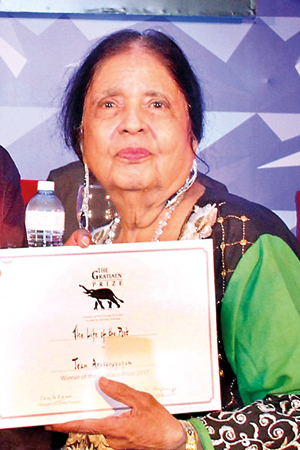Jean Arasanayagam: The Life of the Poet ends

Winning the 2017 Gratiaen: Jean Arasanayagam
Jean Arasanayagam’s garden grew wild and fecund.
Not the garden of the convivial, sylvan Jansz House in Peradeniya- where she lived and entertained with husband ‘Arasa’ and daughters Parvati and Devasundari- but the garden of her poetry: “a luscious overgrown garden”- as reviewer Patricia Melander once said- “that the poet does not want to curb; an organic structure which tellingly has no boundaries”.
Melander enthused about this dense, rambling garden with hibiscus, frangipani, fruit and ‘scissor-beaked parrots’: “Her poetry flows epically, spilling over in a pattern of constant enjambment; the poet’s loquaciousness and inner talking take precedence over form. The uneven chunks of poems are not even limited by our need for breath.”
One will have to get accustomed to the fact that this urgent cascade of inner talking will whisper to us no more- with her ritual outpouring of poetry and occasionally prose being stilled for good. Jean Arasanayagam passed away on Tuesday, August 30, 2019. Wafts in a coincidental line of hers: “The goddess guardian of the freshwater spring is silent”.
Jean wore many hats and exuberantly embraced life. It was fitting that her oeuvre, just like her personality and garb- glowed with exotic tropical warmth.
Born on December 2, 1931 to a genteel Burgher milieu in Kandy, Jean Solomons went to Girls’ High School, Kandy. Growing up, family history was pivotal – interwoven into Hans Christian Andersen and the Grimm Brothers were the colourful Captain Arthur Johnston, a British ancestor making the first forays into royal Kandy, or Adriaan Jansz of the VOC.
After school Jean would lose herself in the amazing ferment and romance bubbling in the Peradeniya University of the ’50s. She would write of its thespian fervour in her very last anthology:
“I cannot go in search of that youthful coterie of/ players whom I rubbed shoulder as we/ trod the Primrose Path of theatrical novitiate,/ those familiar figures enacting our own personal/ unscripted dramas, episode after episode, each/ player assuming the role assigned to play a/ part that they imagine will entrance and grip their/ visible and invisible audience that waits each/ stellar performance.”
As a teacher and mentor at St. Anthony’s College, Katugastota and the Teacher Training College Peradeniya, she inspired a tendresse for the written word in a thousand lackadaisical novices. This was the most important of her passions next to poetry- ‘showing others the path of life’. And of passions she had many- she painted, was a dramatist, and loved food as well as music- including playing the Theremin.
Her own personal saga ran uncannily parallel to the political saga of her island home which she never left- unlike other Eurasian cousins. It was almost as if she was destined to be the poet laureate for the Sri Lankan masses (and not just the middle classes as some would assume), witnessing, participating and chronicling colonialism, post colonialism and the ‘83 riots as well as the ethnic conflict.
But she also created a new, colourful, robust Sri Lankan linguistics with her search of metaphor and imagery, and her abiding quest for “an image which is not stereotypical”.
Nonetheless, the message embedded in each of her stanzas remains universal.
One of the relentless motifs in her poems is her search for an identity and miscegenation of ancestry- where she tries to unravel wildly entangled colonial bloodlines- “archived,/forgotten, locked in thombos, put away”- a source of endless fascination and speculation.
Her love for the vibrancy of the Dravidian culture which was her marital legacy, made her borrow plumage which would drastically pale the dresses of her colonial youth, but she also wholeheartedly embraced the Tamil soulscape- the sculpted masses of gopurams, the domestic felicity around the inner courtyard, the jingle of kovil bells.
The accolades that she accumulated were many. These included the “Sahityaratna” award for her lifetime contributions to literature in this country and the Premchand Fellowship of the Sahitya Akademi, India. She also received a doctorate in letters from Bowdoin College in the USA. Yet the last prize she garnered, the 2017 Gratiaen Award, was very close to her heart.
Professor Walter Perera, who was Chair of the Gratiaen Trust that year, recalls:
“Visibly frail, she initially needed a cane and her daughter’s help to walk towards the dais- before she abruptly abandoned both, collected her award unaided and then delighted the Gratiaen silver jubilee audience with an uninhibited, high octane, acceptance speech.”
“The Life of the Poet” secured Jean the Gratiaen Prize. That “life” is now extinguished—an irreparable loss to her friends and fans in the island and around the world.”
Her poetry will keep her alive. For as she mused, “The life of the poet is made up of fragments/ that create a mosaic patterning of words/ on the walls of temples, sanctuaries, cathedrals/ filled with the symbolic language…/ a sacred map that/ guides the searcher on that journey through/ passage after passage, the tortuous mazes/ and labyrinths of history.”


